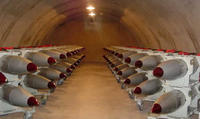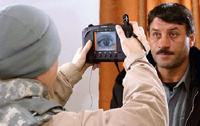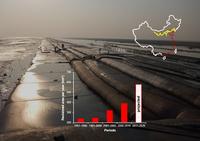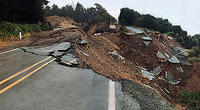-
Debate over California’s Salton Sea rescue plan coming to a head
The California State Water Resources Control Board (SWRCB) is currently reviewing a plan to arrest the deterioration of the Salton Sea, a shallow, saline lake which runs along the state’s Imperial and Coachella valleys above the San Andreas Fault. The Salton Sea was inadvertently created by engineers with the California Development Company when they cut off a series of canals in an effort to manage river flooding between 1904 to 1906. It has since been a popular vacation destination.
-
-
A solution to the U.S. water problem: People who use more water, pay more
Approximately one-third of the United States is in at least a moderate state of drought. Exacerbating the drought is a rapidly increasing population. The U.S. Census Bureau estimates the country’s population will balloon from nearly 310 million in 2010 to more than 420 million in 2060. Experts say that current levels of water consumption cannot continue. One expert says that seasonally adjusted increasing block rates could be the answer. In short, people who use more water, pay more.
-
-
U.S. nuclear arsenal must be upgraded to maintain effective deterrence: Experts

Former military officers, academic strategists, scientists, and congressional leaders have recently been calling for the development of new nuclear weapons to replace the nation’s older, outdated stockpiles. Twenty-five years since the cold war ended, the U.S. nuclear arsenal has been significantly reduced to its current level of 4,804 nuclear weapons — from a peak of 31,000 weapons in 1967.As cooperation with Russia deepened in the 1990s, U.S. weapons complexes deteriorated. A recent “60 Minutes” story on the U.S. nuclear forces found that missileers charged with watching over and controlling Minuteman III ICBMs in Wyoming were still using floppy disks to store critical information. One expert arguing for shoring up and upgrading the U.S. nuclear deterrence says that “one of the reasons deterrence is so valuable is that it provides incentives for self-discipline in the behavior of states that otherwise cannot be trusted to behave peaceably.”
-
-
Cockpit automation causes pilots to lose critical thinking skills

In the wake of recent airline crashes, major news networks have aired concerns about pilots’ ability to accurately fly “by hand” when the airplane’s cockpit automation systems fail. Although many of these concerns have centered on manual skills such as operating the airplane’s controls, new human factors/ergonomics research suggests that pilots’ thinking skills, such as navigating, remaining aware of the status of the flight, and diagnosing troublesome situations, are most vulnerable in today’s automated cockpits.
-
-
Reducing the impact of extreme weather
How do we reduce the impact of extreme weather today while preparing ourselves for future changes? What can we do to build our resilience? A new report from the Royal Society investigates these, and other, key questions to help inform important decisions about adaptation and risk reduction that are being made at global, national and local levels.
-
-
New report highlights “significant and increasing” risks from extreme weather

A comprehensive new report, published by the Royal Society, indicates that exposure of human populations to extreme weather is set to increase as global climate and population size, location, and age continue to change. The report focuses on the risks to people from floods, droughts, and heatwaves. These are some of the most frequent and damaging extreme events that currently occur and their impacts will change with the changing climate. The report also calls for changes to global financial accounting and regulation to ensure that extreme weather risk is made explicit. At present, these risks are not systematically factored into investors’ valuations or assessed by creditors.
-
-
N.M. Electric Car Challenge encourages students’ interests in STEM
Aspiring automotive engineers from twenty-seven middle schools across New Mexico competed in the New Mexico Electric Car Challenge on 22 November at the Highland High School gymnasium in Albuquerque. The goals of the challenge are to present science and math concepts to students in a fun and exciting way, encourage team building, stimulate creative thinking, and develop students’ writing and presentation skills. The New Mexico Electric Car Challenge is a result of the collaboration and commitment of several partners to advance science, technology, engineering, and math (STEM) programs and opportunities for schoolchildren.
-
-
Mobile biometric device expedites identity matching

The Stockton (California) Police Department (SPD) has been quietly testing a state-of-the-art Mobile Biometric Device (MBD) technology for the past four years. Designed quickly to scan fingerprints, irises, and other biological information while officers and evidence technicians are on the field, MBDs can communicate with remote fingerprint databases and confirm matches in as little as three minutes.
-
-
San Francisco to add local groundwater to reservoir supply
The San Francisco Public Utilities Commission has begun digging in the area around Golden Gate Park with the intention of adding local underground water flows to the traditionally sourced water from the Hetch Hetchy Reservoir in Yosemite. The change is expected to take place over the next two years and will replace between 10 to 15 percent of the water supply. Despite the fact that the water is less pure, city officials expect that difference will be negligible.
-
-
Global warming skeptics unmoved by extreme weather
What will it take to convince skeptics of global warming that the phenomenon is real? Surely, many scientists believe, enough droughts, floods, and heat waves will begin to change minds. A new study throws cold water on that theory. Winter 2012 was the fourth warmest winter in the United States dating back to at least 1895. Researchers found, however, that when it came to attributing the abnormally warm weather to global warming, respondents largely held fast to their existing beliefs and were not influenced by actual temperatures. This study and past research shows that political party identification plays a significant role in determining global warming beliefs. People who identify as Republican tend to doubt the existence of global warming, while Democrats generally believe in it.
-
-
China’s second “great wall” is not so great

China’s coastal regions are only 13 percent of the country’s land area, but contribute 60 percent of its gross domestic product. With that come layers of incentives to turn lush wetlands into engines of development and industry. A new study finds that China’s second great wall, a vast seawall covering more than half of the country’s mainland coastline, is a foundation for financial gain - and also a dyke holding a swelling rush of ecological woes.
-
-
New, updated resource on STEM education, workforce
It just became a lot easier for educators, students, parents, policymakers and business leaders to learn more about national trends in education and jobs in science, technology, engineering, and mathematics (STEM). The National Science Board (NSB) last month released an interactive, online resource featuring new and updated data and graphics about STEM education and workforce in the United States and providing facts on topics such as student proficiency, college degrees in STEM fields, and jobs in science-related occupations.
-
-
Los Alamos National Lab: Deploying 100 supercomputers over 60 years in support of national security

From the 1952 MANIAC to Bonanza deployed just this month, Los Alamos National Laboratory has deployed 100 supercomputers in the last sixty years — a showcase of high-performance computing history. The Los Alamos computers deployed along the way include the MANIAC II, which started its nearly 20-year service life with over 5,000 vacuum tubes, all of which were replaced over time with circuit boards. Other deployed systems include Stretch, a technological stretch built in collaboration between Los Alamos and IBM, Serial Number 1 of the iconic Cray-1, and a Thinking Machines CM-5, with its lightning bolt footprint and fat-tree interconnect. By 2008 there came Roadrunner, the world’s first petaflop supercomputer.
-
-
New technology increases awareness of landslide risks

Engineers have created a new way to use lidar technology to identify and classify landslides on a landscape scale, which may revolutionize the understanding of landslides in the United States and reveal them to be far more common and hazardous than often understood. The new, non-subjective technology can analyze and classify the landslide risk in an area of fifty or more square miles in about thirty minutes — a task that previously might have taken an expert several weeks to months. It can also identify risks common to a broad area rather than just an individual site.
-
-
Transforming planes into flying aircraft carriers
Military air operations typically rely on large, manned, robust aircraft, but such missions put these expensive assets — and their pilots — at risk. While small unmanned aircraft systems (UAS) can reduce or eliminate such risks, they lack the speed, range, and endurance of larger aircraft. These complementary traits suggest potential benefits in a blended approach — one in which larger aircraft would carry, launch, and recover multiple small UAS. A flying carrier would allow the United States to use of drones in areas where the United States has no access to nearby airfields, but recovering a drone in mid-air remains a daunting technical challenge.
-
More headlines
The long view
A Shining Star in a Contentious Legacy: Could Marty Makary Be the Saving Grace of a Divisive Presidency?
While much of the Trump administration has sparked controversy, the FDA’s consumer-first reforms may be remembered as its brightest legacy. From AI-driven drug reviews to bans on artificial dyes, the FDA’s agenda resonates with the public in ways few Trump-era policies have.
Risk Assessment with Machine Learning
Researchers utilize geological survey data and machine learning algorithms for accurately predicting liquefaction risk in earthquake-prone areas.
Foundation for U.S. Breakthroughs Feels Shakier to Researchers
With each dollar of its grants, the National Institutes of Health —the world’s largest funder of biomedical research —generates, on average, $2.56 worth of economic activity across all 50 states. NIH grants also support more than 400,000 U.S. jobs, and have been a central force in establishing the country’s dominance in medical research. Waves of funding cuts and grant terminations under the second Trump administration are a threat to the U.S. status as driver of scientific progress, and to the nation’s economy.
The True Cost of Abandoning Science
“We now face a choice: to remain at the vanguard of scientific inquiry through sound investment, or to cede our leadership and watch others answer the big questions that have confounded humanity for millennia —and reap the rewards.”
Bookshelf: Smartphones Shape War in Hyperconnected World
The smartphone is helping to shape the conduct and representation of contemporary war. A new book argues that as an operative device, the smartphone is now “being used as a central weapon of war.”
New Approach Detects Adversarial Attacks in Multimodal AI Systems
New vulnerabilities have emerged with the rapid advancement and adoption of multimodal foundational AI models, significantly expanding the potential for cybersecurity attacks. Topological signatures key to revealing attacks, identifying origins of threats.
